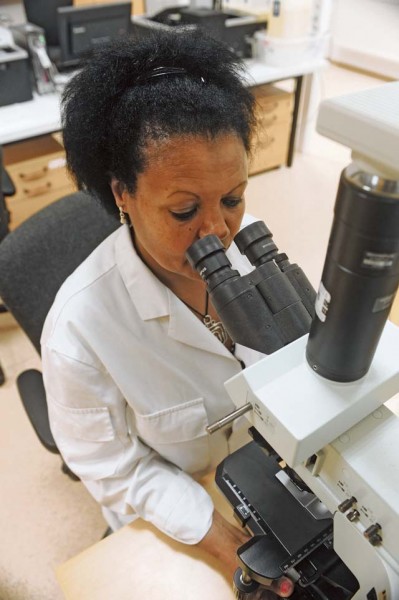
In a laboratory, surrounded by scientific equipment, chemists and physical laboratory technicians review the evidence. Light flashes from one machine, and a technician looks to his screen in hopes of a positive result. These samples, pulled from multiple countries, reveal under microscopes and tests the culprits responsible for damage and loss.
The Army Oil Analysis Program Laboratory Europe provides commanders in Europe, Africa and Southwest Asia with petroleum analysis capabilities at the Kaiserslautern Army Depot. The lab’s primary mission is to accept petroleum samples from both aircraft and ground-based vehicles and analyze them for flaws and inconsistencies. After receipt of the samples, the lab has 24 hours to analyze and report back to the unit of aviation commanders and 72 hours to ground commanders.
“Aviation is given priority because the possibility of loss of life is greater if something goes wrong,” said Akwasi O. Edusei, the AOAP Laboratory administrative support specialist and a native of Kumasi, Ghana. “If an aircraft needs to be grounded because of something we find in the oil, that commander needs to know as soon as possible.”
Each oil sample is extracted, inspected manually by microscope, photographed and electrically tested for impurities. These tests identify water, metallic elements and sediment that could lead to a fault in the equipment or even destruction of a vehicle. Members of the lab liken the oil in a vehicle to the blood pumping through a human body.
“Try to think of the tests we run here in comparison to the tests a doctor would run on a human being. When we test for oil contamination, it is like testing for cholesterol or blood pressure to proactively maintain the body,” Edusei said. “If we need to conduct tests in reaction to a vehicle malfunction it can be compared to a doctor reacting after his patient has a heart attack.”
If one of the tests reveals the potential for a vehicle fault, the lab requests a second sample immediately. The second sample is run through all the same tests to ensure all readings are accurate and to detect if the problem is potentially getting worse. The laboratory personnel then offer their recommendation on how to fix the problem. “Every piece of equipment here is extremely accurate, but we run daily tests on each of our machines to be sure,” said Dr. Davoud Tehranfar, a chemist and lab chief at the AOAP Laboratory and a native of Iran. “If the machines detect the possibility for failure within the oil, then the commander needs to follow our recommendations as soon as possible.”
The AOAP Laboratory aids the European Command, Africa Command and Central Command theaters of operation by saving commanders money and resources through early detection. Finding petroleum faults early lowers maintenance costs, decreases equipment downtime and improves mission capability. Finally, the lab also aids in environmental stewardship by minimizing the amount of oil waste produced by the military, said Edusei.
The AOAP Laboratory has been a part of Europe since 1967, when it was located at Coleman Barracks in Mannheim, Germany. In October of last year, the lab moved to Kaiserslautern Army Depot as a part of restructuring of U.S. Army Europe.
“The move to Kaiserslautern is very beneficial to both the lab and the mission,” said Heidi Bodeit, the AOAP laboratory technician and a native of Gau-Bickelheim, Germany. We are centrally located to serve all units in the Kaiserslautern Military Community and our proximity to Ramstein Air Base allows for fast receipt of samples coming from other countries.”
Both U.S. and NATO commanders desiring the services of the AOAP Laboratory can do so even if they are not enrolled in the program. For more information contact Bodeit at 314-483-7980.


